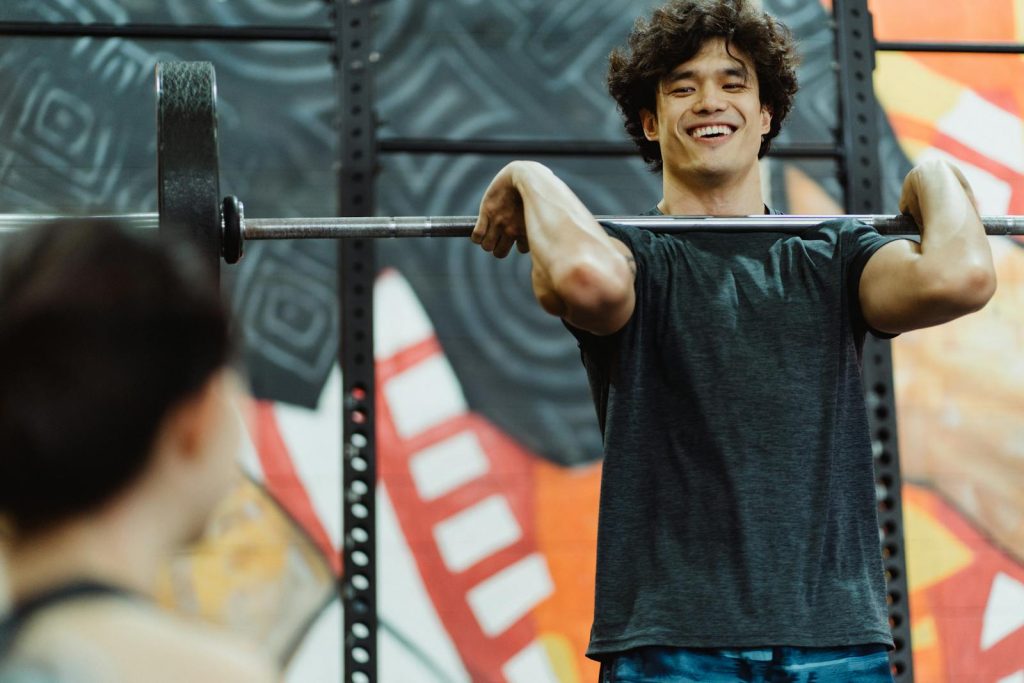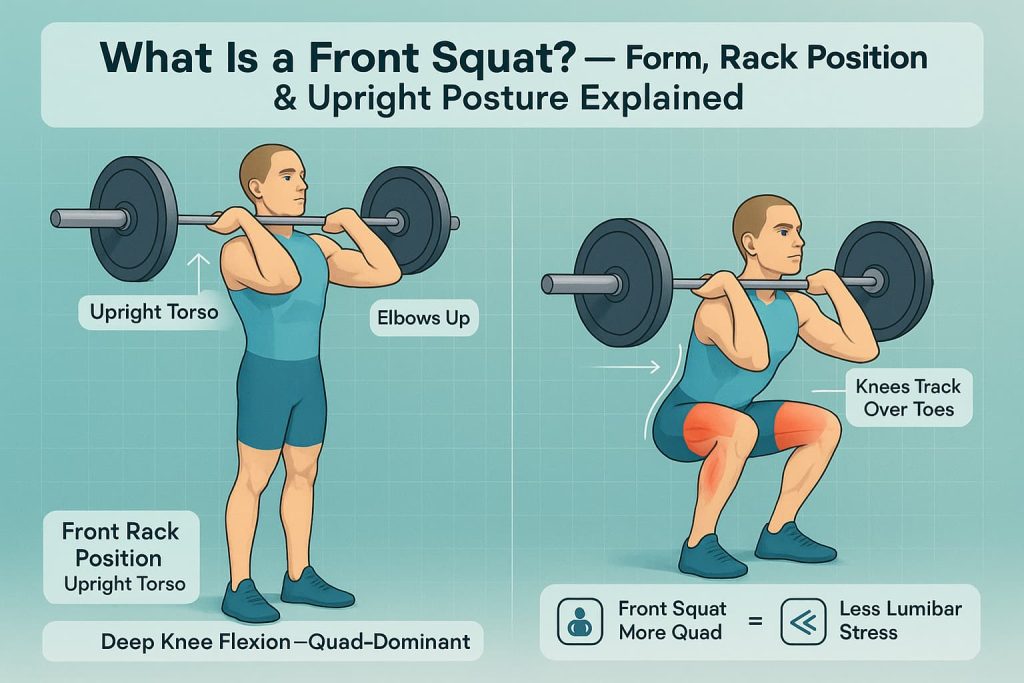The front squat is one of the most effective exercises for building strong quads and improving posture. The front squat keeps your torso more upright than a back squat, reducing spinal load while targeting the quadriceps intensely.

This makes it a favorite for strength athletes, beginners, and anyone looking for safer knee-dominant leg training. Understanding how the front squat works helps you lift with better form, avoid injury, and build strength that translates to real-life movement.
In this guide, you’ll learn the benefits, proper technique, common mistakes, variations, programming tips, and FAQs—along with external authoritative references.
What Is a Front Squat?
A front squat is a barbell squat variation where the weight rests on the front side of your shoulders, in the “front rack” position. This shifts your center of gravity forward, encouraging an upright torso and greater knee flexion.
Compared to the back squat:
- It is more quad-dominant
- It reduces lumbar shear forces
- It requires strong core and upper-back stability
- It demands good wrist, shoulder, and thoracic mobility

Warm-Up Before You Begin
A brief warm-up prepares your wrists, shoulders, hips, and ankles for the front squat’s upright position. It improves mobility, posture, and control.
Quick Warm-Up (2–3 Minutes):
- Arm circles – 20 seconds
- Wrist circles – 10 each way
- Bodyweight squats – 8 reps
- Thoracic rotations – 8 each side
- Ankle rocks – 10 per side
How to Do the Front Squat (Step-by-Step)
1. Setup
- Stand with feet hip–shoulder width apart.
- Place the barbell across the front of your shoulders.
- Use either a clean grip (hands outside shoulders, elbows high) or a cross-arm grip if mobility is limited.
- Raise elbows so they’re parallel to the floor.
- Brace your core and keep your chest tall.
2. Descent
- Inhale deeply.
- Sit between your hips, not straight down.
- Keep elbows high and spine neutral.
- Knees track over your toes.
- Keep heels planted.
3. Ascent
- Exhale as you stand tall.
- Drive through midfoot and heel.
- Keep elbows high to avoid the bar rolling forward.
- Lock out hips and knees at the top without overextending.
Muscles Worked in the Front Squat
The front squat is a quad-dominant compound movement that also trains the core and upper back.
Primary Muscles:
Quadriceps
Secondary Muscles:
Glutes, hamstrings (stabilizers), calves, core, spinal erectors, traps, rhomboids
Common Mistakes to Avoid
- Elbows Dropping: This causes the bar to roll forward, rounding the spine. Keep elbows lifted throughout the movement.
- Leaning Too Far Forward: This shifts tension off the quads and increases lumbar stress. Stay upright.
- Knees Collapsing Inward: This increases knee strain. Keep them aligned with your toes.
- Using a Load Too Heavy: Start lighter than your back squat. Technique is crucial with front squats.
- Poor Wrist or Shoulder Mobility: Limited mobility can cause pain or poor bar positioning. Warm up properly and use mobility drills when needed.
Benefits of the Front Squat
1. Builds Stronger Quadriceps
Research shows front squats emphasize the rectus femoris and vastus muscles, producing high quadriceps activation due to the upright torso and increased knee-dominant mechanics.
2. Improves Posture & Upper-Back Strength
Because the bar sits on the front of your body, your torso must stay vertical. This strengthens the:
- Upper back
- Thoracic spine
- Deep core
These improvements carry over to daily movements and other lifts.
3. Reduces Lower-Back Stress
Biomechanics studies show that front squats create lower compressive and shear forces on the spine, making them a safer alternative for many lifters with back sensitivity.
4. Boosts Athletic Power & Mobility
Front squats improve:
- Knee flexion mobility
- Hip mobility
- Upright positioning for Olympic lifts
- Sprinting and jumping power
Athletes often rely on front squats for clean and jerk strength.
5. Great for Beginners and Home Workouts
Goblet squats and dumbbell/kettlebell front squats let beginners learn the movement safely
Front Squat Variations
1. Clean-Grip Front Squat
Why it works:
The clean-grip front squat reinforces strong upper-back and core engagement while allowing the bar to sit securely in the front rack position. This variation mimics the receiving position of Olympic lifts, improving posture, strength, and explosiveness for athletes.
Muscles worked:
Quadriceps, gluteus maximus, hamstrings, erector spinae, deep core, upper back (traps, rhomboids), forearm flexors (stabilization)
How to do it:
- Grip the bar slightly outside shoulder width with full hand around the bar.
- Bring the elbows forward and up so they remain parallel to the floor.
- Stand tall with the bar resting on the front deltoids/clavicles.
- Inhale, brace your core, and squat by sitting between your hips.
- Keep your torso upright, elbows high, and knees tracking over toes.
- Drive through heels and midfoot to stand back up while maintaining bar position.
Trainer Tip:
If wrist mobility is limited, warm up with front-rack stretches or use only two fingers on the bar during the lift.
2. Cross-Arm Front Squat
Why it works:
This variation allows lifters with limited wrist or shoulder mobility to maintain a secure front rack without discomfort. It promotes the same upright torso and quad-dominant mechanics as the clean-grip version.
Muscles worked:
Quadriceps, glutes, hamstrings, core stabilizers, upper-back musculature
How to do it:
- Place the bar on your front shoulders in the rack position.
- Cross your arms so each hand rests on the opposite shoulder.
- Lift elbows high to create a shelf for the bar to rest on.
- Inhale and descend into a squat while keeping the torso tall.
- Drive through your feet to return to standing.
Trainer Tip:
Keep elbows pointed straight ahead the entire time—if they drop, the bar will roll forward.
3. Dumbbell Front Squat
Why it works:
The dumbbells help beginners learn upright posture and proper knee tracking without the mobility demands of a barbell front rack. It also trains unilateral stability because each side of the body handles its own load.
Muscles worked:
Quadriceps, glutes, hamstrings, core, upper back, forearm stabilizers
How to do it:
- Hold two dumbbells at shoulder height with elbows tucked slightly forward.
- Stand with feet hip–shoulder width apart.
- Brace your core and descend into a squat.
- Keep dumbbells steady and torso tall.
- Stand back up while pressing through the heels and midfoot.
Trainer Tip:
Avoid letting the dumbbells flare outward—keep them close to your body to maintain balance and posture.
4. Kettlebell Front Squat
Why it works:
Kettlebells increase the demand on the core and stabilizers due to their offset center of gravity. The rack position also improves shoulder stability and upper-body control.
Muscles worked:
Quadriceps, glutes, hamstrings, deep core muscles, upper back, shoulder stabilizers
How to do it:
- Rack two kettlebells at shoulder height (or use one if learning).
- Keep elbows tight to your ribs and chest tall.
- Inhale and squat down with knees tracking forward.
- Maintain a neutral spine as you lower.
- Drive up through your feet to stand.
Trainer Tip:
Keep your ribs stacked over your pelvis—kettlebells often tempt lifters to lean back or flare the ribs.
5. Goblet Squat
Why it works:
This beginner-friendly variation teaches proper squat depth, posture, and knee alignment. The front-loaded weight naturally encourages an upright torso and helps build foundational strength.
Muscles worked:
Quadriceps, glutes, hamstrings, core, upper back
How to do it:
- Hold a dumbbell or kettlebell by the horns close to your chest.
- Stand with feet hip–shoulder width apart.
- Brace your core and sit between your hips.
- Keep elbows inside knees as you descend.
- Stand tall by pushing through heels and midfoot.
Trainer Tip:
If you struggle with depth, elevate your heels slightly or use a wedge to help improve mobility and positioning.
Regressions & Progressions
Regressions:
- Goblet Squat: Easiest way to learn upright posture.
- Dumbbell Front Squat: Less mobility-demanding than a barbell.
- Heeled Squat: Helps achieve depth if ankle mobility is limited.
Progressions:
- Clean-Grip Front Squat: Standard advanced variation.
- Paused Front Squat: Builds stability and control.
- Tempo Front Squat: Slower descent increases time under tension.
Front Squat vs. Back Squat: Which Is Better for You?
Front Squat:
More upright, quad-focused, core-demanding, and often easier on the lower back.
Back Squat:
Allows heavier loads, more hip-dominant, and builds total lower-body strength.
Choose front squats for posture and quad development.
Choose back squats for maximal strength and glute emphasis.
Use both for balanced training.
Programming Guidelines
For Strength
- 3–5 sets
- 3–6 reps
- 75–85% of 1RM
- 2–3 minutes rest
For Muscle Growth (Hypertrophy)
- 3–4 sets
- 6–10 reps
- 60–75% of 1RM
- Controlled 2–3 second lowering phase
For Athletes
- 2–4 sets
- 3–6 reps
- Moderate to heavy load
- Focus on speed, posture, and clean technique
Weekly Frequency
- 1–2 sessions per week for most lifters
- Pair with back squats or lunges for balanced lower-body development
Safety Tips
- Keep elbows high to maintain bar stability.
- Stay upright to reduce stress on the lower back.
- Use proper wrist/shoulder mobility drills before lifting.
- Start with goblet squats if you’re new to the front rack position.
- Increase weight gradually—this lift is technique-driven.
- Stop immediately if you feel pain in the knees or lower back.
FAQ
1. Are front squats better than back squats?
Not “better,” but they target different mechanics. Front squats are more quad-focused and easier on the lower back.
2. Should beginners do front squats?
Yes—starting with goblet or dumbbell front squats is a safe progression.
3. Why do my wrists hurt during front squats?
Usually limited wrist or shoulder mobility. Try a cross-arm grip or mobility warm-ups.
4. Do front squats build abs?
Indirectly. The upright posture requires heavy core engagement.
5. How much lighter is the front squat compared to the back squat?
Most lifters use 20–30% less weight in the front squat due to the upright posture and mobility demands.
6. Can front squats help with posture?
Yes—the thoracic extension demand strengthens posture muscles.
7. Are front squats safe for bad knees?
Often yes, because they allow a more upright torso, but always consult a qualified professional if you have knee issues.
Conclusion
The front squat is one of the most effective lifts for building powerful quads, improving posture, and strengthening your core and upper back. Its upright mechanics make it safer for many lifters while still delivering exceptional strength and muscle-building results.
If you want a leg exercise that boosts strength, mobility, and functional performance, the front squat deserves a place in your program. Start light, prioritize form, and progress steadily.
(This content is for informational purposes only and not medical advice.)
References
- Gullett JC, Tillman MD, Gutierrez GM, Chow JW. A biomechanical comparison of back and front squats in healthy trained individuals. Journal of Strength and Conditioning Research. 2009.
https://pubmed.ncbi.nlm.nih.gov/19002072/ - Yavuz HU, Erdag D, Amca AM, Aritan S. Kinematic and EMG activities during front and back squat variations in maximal loads. Journal of Sports Sciences. 2015.
https://pubmed.ncbi.nlm.nih.gov/25630691/ - Straub RK, et al. A biomechanical review of the squat exercise: implications for clinical practice. International Journal of Sports Physical Therapy. 2024.
https://ijspt.scholasticahq.com/article/94600-a-biomechanical-review-of-the-squat-exercise - Kim J. Lower body kinematic comparisons between front and back squats. Master’s thesis, Bridgewater State University. 2014.
https://vc.bridgew.edu/cgi/viewcontent.cgi?article=1002&context=theses - Behm DG, et al. Potential effects of dynamic stretching on injury incidence and performance. Sports Medicine. 2023.
https://pmc.ncbi.nlm.nih.gov/articles/PMC10289929/